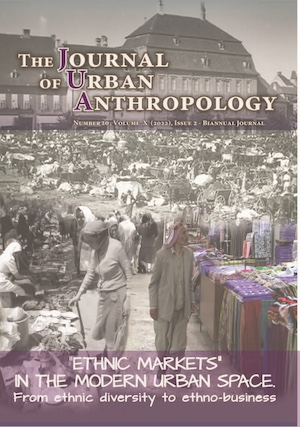Identity, otherness and commerce in times past Bucharest: „The Flea Market”
Identity, otherness and commerce in times past Bucharest: „The Flea Market”
Author(s): Alexandra RusuSubject(s): Economic history, Social history, Social differentiation, Nationalism Studies, Economic development, 19th Century, Pre-WW I & WW I (1900 -1919), Interwar Period (1920 - 1939), History of Antisemitism, Financial Markets, Ethnic Minorities Studies, Socio-Economic Research, Identity of Collectives
Published by: EDITURA OSCAR PRINT
Keywords: identity; otherness; commerce; nationalism; antisemitism;
Summary/Abstract: “The flea market” was a place intended for the old furniture trade, but also other items that today we generically call second-hand goods, which appeared on the Bucharest trade map in the second half of the 19th century. It was erected in a disadvantaged area, densely populated, marked by the Jewish singularity. For more than half a century(1876-1930), the activity in the flea market, coordinated exclusively by Jewish merchants,had an undeniable role in the capital’s economy. Regarding its image, it was painted in the context of new socio-political realities in the Old Kingdom of Romania, such as the awakening of nationalistic feelings and xenophobia, especially antisemitism. In the last decades of the 19th century, the “Jewish Question” became an intellectual problem with an essential political stake, the emancipation of the Jews being in an irreconcilable position with Romanian nationalism. The anti-Semitic discourse used by the political, intellectual,and cultural elite presented the Jews as unassimilable, anti-national elements that could undermine the Romanian character. Examples from the periphery of life, including the Jewish merchants in Lazăr Street and the “Flea market”, constitute the extreme otherness and a potential danger to the nation’s body, thus emphasizing the opposing nature discourse and favoring an ideology of excluding Jews from Romanian culture and society.The research aims to capture the flea market atmosphere and the image of the Jewish community nearby, as reflected in the writings of some personalities (politicians, historians,prose writers, journalists) of times past Bucharest. The perspectives exhibit a wide range of observations, from objective ones, in contrast to the circulated stereotypes, to subjective ones, filtered through emotions, all pieces of the collective mind’s mosaic. Examples in the press oscillate between fin-de-siècle anti-Semitism and the anti-Semitism of the early 20thcentury, infused with scientific claims, all using the flea market as a symbol of inadequacy for an entire ethnic community
Journal: THE JOURNAL OF URBAN ANTHROPOLOGY
- Issue Year: 10/2022
- Issue No: 20
- Page Range: 165-177
- Page Count: 13
- Language: English
- Content File-PDF

